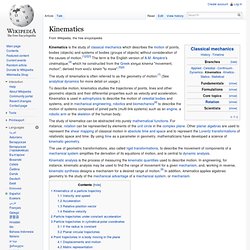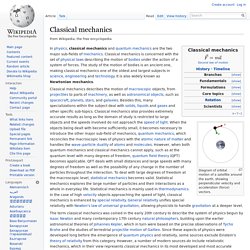

Work and Energy. Force. Frames of Reference. Velocity and speed. Acceleration. For example, an object such as a car that starts from standstill, then travels in a straight line at increasing speed, is accelerating in the direction of travel.

If the car changes direction at constant speedometer reading, there is strictly speaking an acceleration although it is often not so described; passengers in the car will experience a force pushing them back into their seats in linear acceleration, and a sideways force on changing direction. If the speed of the car decreases, it is sometimes called deceleration; mathematically it is simply acceleration in the opposite direction to that of motion.[4] Definition and properties[edit] Acceleration is the rate of change of velocity.
At any point on a trajectory, the magnitude of the acceleration is given by the rate of change of velocity in both magnitude and direction at that point. Kinematics. The study of kinematics is often referred to as the geometry of motion.[7] (See analytical dynamics for more detail on usage.)

To describe motion, kinematics studies the trajectories of points, lines and other geometric objects and their differential properties such as velocity and acceleration. Kinematics is used in astrophysics to describe the motion of celestial bodies and systems, and in mechanical engineering, robotics and biomechanics[8] to describe the motion of systems composed of joined parts (multi-link systems) such as an engine, a robotic arm or the skeleton of the human body. The study of kinematics can be abstracted into purely mathematical functions.
Relativity. Classical mechanics. Diagram of orbital motion of a satellite around the earth, showing perpendicular velocity and acceleration (force) vectors.

In physics, classical mechanics and quantum mechanics are the two major sub-fields of mechanics. Classical mechanics is concerned with the set of physical laws describing the motion of bodies under the action of a system of forces.